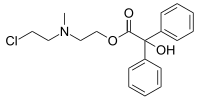Benzilylcholine mustard
Benzilylcholine mustard (N-2-chloroethyl-N-methyl 2-aminoethyl benzilate) is a modified version of acetylcholine, so named because after cyclization in solution it forms an iminium derivative that is structurally similar to benzilylcholine. It is well known for being an irreversible antagonist of the muscarinic acetylcholine receptor.[1] It has been used in pharmacological experiments investigating the relationship between receptor occupancy and response. It was also one of the tools in characterization of the muscarinic acetylcholine receptor.[2]
 | |
| Names | |
|---|---|
| IUPAC name
2-(2-chloroethyl-methyl-amino)ethyl 2-hydroxy-2,2-diphenyl-acetate | |
| Other names
N-2-chloroethyl-N-methyl 2-aminoethyl benzilate, α-Hydroxy-α-phenylbenzeneacetic acid 2-[(2-chloroethyl)methylamino]ethyl ester | |
| Identifiers | |
3D model (JSmol) |
|
| ChemSpider | |
PubChem CID |
|
CompTox Dashboard (EPA) |
|
| |
| |
| Properties | |
| C19H22ClNO3 | |
| Molar mass | 347.836 g/mol |
Except where otherwise noted, data are given for materials in their standard state (at 25 °C [77 °F], 100 kPa). | |
| Infobox references | |
Mechanism
On the muscarinic acetylcholine receptor, benzilylcholine mustard acts as an alkylating agent at two sites, one site being the acetylcholine recognition site itself, and the other a site that stabilises the receptor in its inactive state.[3] Groups that can be alkylated in this way include thiols, alcohols, imines and carboxylic acids.[4]
References
- Gill, E.W.; Rang, H.P. (July 1966) "An Alkylating Derivative of Benzilylcholine with Specific and Long-Lasting Parasympatholytic Activity", Molecular Pharmacology, vol.2 no.4 284-297
- Gupta, Surendra K.; Moran, John F.; Triggle, David F. (November 1976) "Mechanism of Action of Benzilylcholine Mustard at the Muscarinic Receptor", Molecular Pharmacology, vol.12 no.6 1019-1026
- Gupta, Moran, Triggle (1974)
- John C. Foreman, Torben Johansen, Alasdair J. Gibb (2009) Textbook of Receptor Pharmacology, Third Edition, CRC Press, page 51